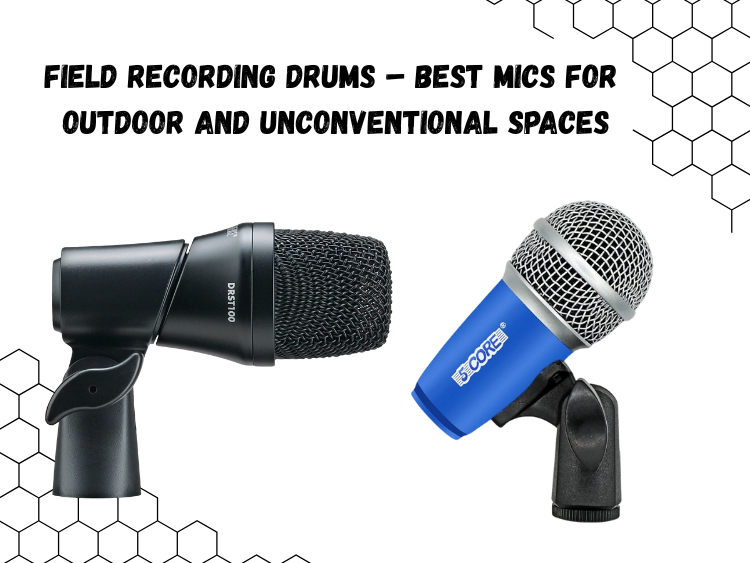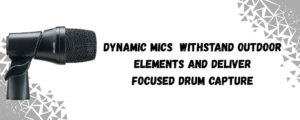There’s something raw and honest about taking a drum kit outside the studio. Whether it’s a rooftop jam, a forest breakdown, or a gritty alley groove—field recording drums opens up a world of sonic texture you’ll never get from sound-treated walls.
But here’s the catch: drums aren’t easy to record in controlled rooms, let alone on uneven ground with birds, traffic, and wind in the mix. You need the right strategy. And most importantly, the right mics.
Here’s how to approach outdoor drum recording without compromising clarity, tone, or vibe.
1. Know the Space Before You Hit Record
Field recording starts long before you set up a mic. First step? Scout the location. Are you on grass, concrete, or sand? Are there natural reflections (walls, cliffs, trees), or is it wide open?
Different spaces color the sound in wildly different ways. Tight alley? You’ll get natural slapback. Open field? No reflections—just pure, dry hits.
Treat the location like an extension of your drum kit. It’s not just about recording drums outdoors—it’s about recording the outdoors with your drums.
2. Use Dynamic Mics First—Always
Forget fragile condensers unless you’ve got ideal conditions and wind protection. Field environments are unpredictable, and dynamic mics hold up better to bumps, drops, humidity, and ambient noise.
The 5 Core 7-Piece Drum Mic Kit is built for exactly this kind of work—solid housing, no-fuss setup, and tuned specifically for bass, snare, and toms. Whether you’re in a warehouse or under an overpass, you’re getting focused capture with minimal bleed.
Interestingly, 5 Core even provides great discounts to business owners if you’re buying in bulk. Refer to this site for more information. Here’s also a one-stop platform where you can find all their products.
Plus, having individual mics for each drum gives you the flexibility to re-EQ and treat each hit after the fact—a lifesaver when the environment shifts mid-session.
3. Isolate What You Can, Embrace What You Can’t
Outdoors, you can’t control every noise. So don’t try to fight it—work with it. Embrace the passing plane, the distant thunder, the crack of leaves underfoot. These become part of your drum sound.
What you can control is mic isolation. Keep your snare and kick mics close—right up on the head. Use tight cardioid patterns to reject ambient bleed. If you’re working with toms, angle the mics inward and keep cables neat to avoid trip hazards or wind flapping.
Set your gain lower than usual to avoid clipping from surprise peaks—outdoor spaces can be deceiving in how sound carries.
4. Don’t Skip the Kick Mic
It’s tempting to go minimal with field kits—but leave out the kick mic and your recording will fall flat. You need that punch to ground the rhythm, especially in wide-open spaces where low end can easily vanish.
This is where both the 5 Core kit and the Shure DMK57-52 Drum Mic Set earn their keep. Both include a dedicated kick mic designed to isolate that deep thump without capturing every car horn in the background.
Even better, bury the kick slightly behind a small blanket or foam baffle. It won’t kill the vibe but will knock out some wind and nearby reflections.
5. Wind Is the Real Enemy
Nothing wrecks a field recording faster than wind hitting a mic diaphragm. It distorts low frequencies and creates unusable rumble.
Foam windscreens are a minimum. Deadcats are better if it’s breezy. Even a hoodie or extra sock over the mic can help in a pinch—whatever works to block airflow while letting sound through.
If you’re serious about field miking techniques, bring makeshift barriers: a folding table, backpack wall, or even a piece of cardboard to deflect gusts. Doesn’t have to be pretty—just functional.
6. Mono Overheads Beat Stereo Outdoors
Stereo overheads are beautiful in studios. But outside, they often cause more trouble than they’re worth—too much ambient noise, too much phase risk, and too little control.
Instead, go with a single overhead dynamic or a rugged small-diaphragm condenser (only if conditions allow). Place it about two feet above the snare, aimed slightly toward the toms. You’ll still get cymbal wash, stick attack, and spatial texture—without doubling your wind exposure or phasing headaches.
7. Track First, Shape Later
With field recording, post-production is your best friend. Focus on getting a clean take in the moment. Don’t obsess over EQ or mix decisions on-site.
Back in the studio, high-pass filters clean out the mud. Multi-band compression tames background chaos. Reverb and delay fill in the gaps the environment didn’t. The goal is to preserve the vibe—not polish it out of existence.
Pro tip: layer your outdoor kit with subtle samples underneath for extra impact. Blend, don’t replace. You’ll get modern weight with organic feel.
Final Word
Recording drums outside the studio isn’t about perfection. It’s about feel, space, and a sound you can’t fake indoors. But with the right mics and a smart setup, you can capture something way more powerful than a sterile studio track.
Field miking takes patience, adaptability, and gear that won’t flinch when the wind picks up or the rain starts to mist. And that’s what separates a shaky phone recording from a field session that actually slaps.




